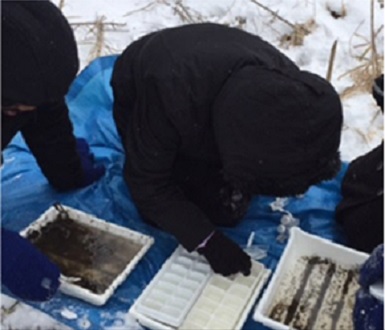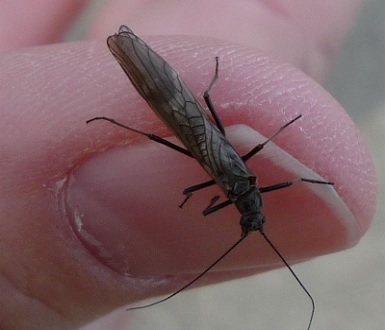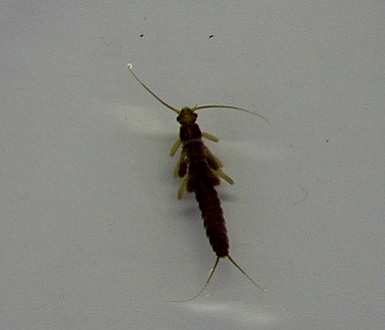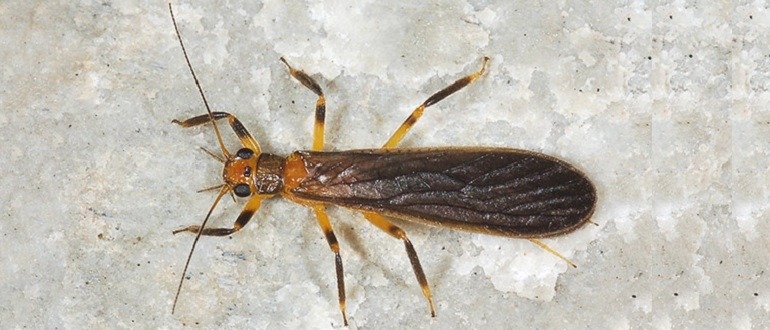A Journey to the Ice and Snow
GET TO KNOW Winter Stoneflies
In the coldest days of winter, when the water freezes over, a tiny bug lives under the ice and snow.
FUN FACT: Stoneflies are important indicators of water quality because they spend most of their life in the water and require very clean, well-oxygenated water to survive. Some have very fine gills under their abdomens. Stonefly nymphs do miniature push-ups on the stream bottom to increase the flow of water (and dissolved oxygen) across their tiny gills and bodies. Apparently, even this tiny, little bug knows it needs a good exercise routine!
Hidden away, a winter stonefly nymph crawls happily about the bottom of the frigid stream. Here, it has sheltered many months under the rocks and stones. But now, the time has come for the nymph to leave its watery home and climb – to the wintry world above. The journey is perilous. And, if it even survives, the stonefly nymph will emerge into a world that is colder and more hostile than the one he left behind.
Stoneflies are one of the very few insects to fully embrace the cold of winter. And because these highly sensitive insects are excellent indicators of water quality, their annual winter emergence from the river – sometimes in vast “hatches” of many thousand – is cause for celebration. Bug-lovers across the continent gather every January/February to witness the hatch and take stock of watershed health.
Stonefly nymphs were first officially recorded in the Rouge River during FOTR’s 2001 Fall Bug Hunt. Excited by the find, FOTR scheduled a special Winter Stonefly Search for January 2002. In that first search, winter stoneflies were found at four Rouge River tributaries (Johnson, Fowler, Fellows, and Tonquish Creeks).

It was happy news, and FOTR has conducted annual January Stonefly Searches every year since.
Unfortunately, our stoneflies are in danger. A 2020 study (by Tim Maguire and Scott Mundle) indicates Rouge River stonefly populations are declining with an estimated 4.8% effective extinction rate. Since the Rouge watershed is highly urbanized, the loss of tree cover to hard paved surfaces creates a “heat island” effect that raises summer water temperatures. Such increases in water temperature can reduce levels of dissolved oxygen and harm many aquatic species. Please see Community Science for more information.
HABITAT & LIFE CYCLE
There are thousands of species of stoneflies in the world. Overall, they exhibit similar life cycles. As aquatic macroinvertebrates, stoneflies spend the greatest portion of their lives (for some, as long as 3 years) as water-bound nymphs. Nymphs have fully formed bodies and legs (sans wings) and may pass through as many as 30 morphs before leaving the water. Once emerged, adult stoneflies live only a few short days or weeks. Curiously, stoneflies neither fly – nor swim – very well. Instead, they crawl. As nymphs, they crawl around under stones in the river’s substrate; and as adults, they crawl along rocks and logs at the river’s edge.


It is the cold-loving winter stoneflies, that thrive in January when the river’s dissolved oxygen levels are at a peak. During summer, these nymphs often burrow into the river bottom to snooze away hot days in a lowered metabolic state of diapause. Then, as fall cools the water, winter stoneflies wake to move back into the flowing water of the stream.
A winter stonefly nymph generally reaches its final stage, and climbs from the river, in late winter or early spring. Only 1/2 inch long, it is still quite small. The journey across the riverbed and up the bank is fraught with danger. For even in winter, there are hungry fish. Crawling from the water, often through layers of ice and snow, the nymph must seek a hiding place to complete a final molt to adult form. Newly exposed to the dangers of hungry birds and cold winter winds, an adult stonefly has but a few short days of life to find a mate.
With great urgency, the little stonefly seeks a mate via a courtship serenade. Rhythmically thumbing his body against his perch, a male drums out his call until an interested lady drums her reply. Following their own music, the two find each other and mate. Soon, the female lays her eggs at the surface of the water (or ice), and the eggs of the next generation slowly settle to the relative safety of the riverbed.
Check out this video showing the life cycle of a stonefly.
TAKE ACTION
Each year, FOTR gathers data on stonefly nymphs during the January Stonefly Search, set for January 23, 2021 this year. Register today. This is an excellent opportunity to help FOTR evaluate river health and water quality. If you would like to learn more about these sensitive insects in the Rouge, sign up for our virtual “Stonefly Refresher” on Jan. 11 at 6 pm.
Additionally, you can help protect these insects from the heat island effect by replacing paved surfaces with pervious ones and planting native trees and plants. If you live along any waterbody, maintaining a buffer zone of native plants help protect it. You can learn more through our Rain Smart program to make your yard more river friendly for the tiny stonefly and all creatures of the watershed.
MAIN PHOTO CREDIT: slender Winter Stonefly on the ice – photo: FOTR
